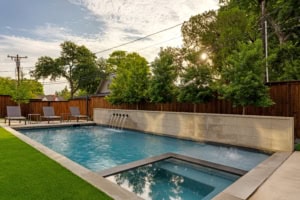Pushing the winter blues aside, heating those grills, pulling out sunshades, and getting ready for Memorial Day weekend mean one thing: Summer’s here! And with it comes the pleasure and responsibility of maintaining your swimming pool to ensure it remains crystal clear, hygienic, and fun-filled all through summer. Here are your pool maintenance tips for a sparking summer!

Here are some tips to keep your pool in sparkling condition all summer.
1. Keep Circulation Going Strong
First on our list: Circulation. Having the pool water in constant movement is key to maintaining its tip-top condition. Stagnant water breeds algae and bacteria, not to mention it’s where bugs and frogs lay their eggs. You might just end up with a green, marshy habitat! Scary? Absolutely.
So run that pool pump daily for at least 8-10 hours in strong summer sunlight to keep the water moving and refreshed. Don’t forget to also clean out the skimmer and pump baskets weekly to ensure proper water flow.
Tip: Install an automatic timer for your pump to ensure steady flow even when you forget to switch it on. Also, to ensure pristine pool water, occasionally redirect the eyeball jets or aim them down toward the bottom of the pool to stir up stagnant particles that might settle.
2. Test and Balance Water Chemistry Regularly
Pool water chemistry is so much more fun than your high school lab sessions because it deals with something we love: our pools. It might be a bit of a task, but it’s necessary to ensure your pool water isn’t breeding harmful bacteria or causing irritating skin conditions.
Alkalinity, pH, and calcium hardness are the three essential elements to keep tabs on. Aim for these levels:
These might seem like a mouthful, but store kits are readily available to help you monitor them efficiently. They’re so easy to use that it’s often called “dip and read.” Just immerse those strips and get your reading. There might be a bit of tweaking required to keep it all balanced, but the result is worth the effort: clear, sparkly water that’s gentle on your eyes and skin.
3. Shock Your Pool Weekly
Shocking your pool means adding a large dose of chlorine or other sanitizer to kill contaminants. Do this weekly during heavy use periods or after heavy rain. Always shock in the evening and run the pump overnight to distribute chemicals correctly. Don’t forget to wait until the chlorine level drops back to 1.0 – 3.0 ppm before swimming again.
Tip: Always pre-dissolve pool shock in a bucket of water before adding it to the pool. This prevents bleaching of pool surfaces and ensures even distribution. When adding the shock, walk around the pool’s edge, pouring the mixture slowly into different areas for optimal coverage.
4. Brush and Vacuum Regularly
Even with good circulation, your pool’s filtration system could miss some spots. Corners or areas behind steps may hide dirt and require a manual touch-up from time to time. Aim to brush at least once a week using a pool brush attached to your telescopic pole. When brushing, start from the shallow end and work towards the deep end, directing debris towards the main drain.
This helps your filtration system remove loosened dirt more efficiently. Pay extra attention to corners and behind ladders where algae likes to hide. You can use nylon brushes for vinyl pools or stainless-steel brushes for concrete ones.
As for vacuuming, it’s simple: hook up your manual vacuum head onto its pole, connect your vacuum hose to the skimmer, and ensure no air gets into the system. Vacuum in a slow, methodical pattern, overlapping each pass slightly to ensure full coverage.
This prevents kicking up debris and ensures thorough cleaning. Auto vacuums are also great alternatives if you’re too busy or simply not inclined towards manual labor.
5. Monitor and Clean the Pool Filter
Filters are your best friend in maintaining clear pool water, as they take care of suspended particles, dirt, and contaminants. But this means that over time, they can get clogged up and require cleaning.
Keep an eagle eye on your pressure gauge. If it begins to climb 8-10 lbs above its clean reading — which is what it read when you last cleaned it — it’s probably a good sign that your filter is due for cleaning.
Here’s how: Cartridge filters require turning off the system power, removing the cartridge(s), giving them a thorough spray with a garden hose, and letting them dry before reinstalling them.
Remember that even after cleanings, if cartridges show discoloration or damage, replace them promptly.
Pro tips:
● For sand or DE filters, backwash when the pressure gauge rises 8-10 psi above normal. This helps maintain optimal filtration efficiency.
● Consider using a filter cleaner solution periodically to remove oils and deeply embedded debris that regular backwashing may miss.
6. Top Off Your Water Level
Summer heat combined with increased use leads to faster-than-normal water evaporation, so keeping track of water levels becomes critical during summertime pool maintenance.
If it seems too low, below halfway down the skimmer intake, adjust accordingly by adding more naturally sourced water from your garden hose until levels seem just right again.
Just keep an eye on those chemicals once you’re refilled as you’ll likely need to adjust them back into balance –– the fresh water will dilute the previous balances quite dramatically.
Pro tips:
● Install an auto-fill device to maintain consistent water levels without manual intervention. This can help prevent damage from low water levels.
● After topping off, run the pump for at least 4-6 hours to properly circulate and mix the new water with existing pool water before retesting and adjusting chemicals.
7. Keep an Eye on the Weather

Weather can play a significant role in your pool maintenance during summer. Hot, sunny days use up chlorine and encourage algae growth, while rainfall dilutes chemicals. High winds blow leaves and other debris right into your swimming paradise.
Always keep a close eye on forecasts to preemptively handle these situations: you might need to add extra sanitizer on hot days, test and balance chemistry after rainfall, or skim more frequently during windy periods.
Pro tips:
8. Landscaping Around the Pool
For those contemplating how to landscape around an in-ground pool: always choose plants that don’t shed too much. This will save you tons of cleaning time by keeping leaves or blooms away from the water’s surface as much as possible.
Also, consider installing windbreaks if frequent gusting disrupts your peaceful swim time by blowing dust particles onto water surfaces. Not to mention, that’ll require frequent vacuuming later on.
For more inspiration on integrating your pool with your overall outdoor design, check out our article on incorporating textured landscapes into your design.
9. Pay Attention to Your Pool’s Appearance

You shouldn’t just take a dip in your pool. You should observe it. This might seem obvious, but how many times have we simply ignored the slight changes to our pool’s appearance? If the water looks dull, cloudy, or has visible algae growth, don’t just shrug and ignore it; these are signs that your pool needs attention.
If you spot any color change, like a greenish tinge showing up on walls and the pool bottom, look out! You have algae blooming there. Fix this quickly before it gets out of hand by scrubbing away those spots with a sturdy brush and chlorine combo followed swiftly by algaecide treatment and shock dosage application.
Apart from this, keep an eye open for slippery surfaces around the skimmer inlet or stairs indicating lurking bacteria presence which, again, calls for immediate shocking.
Unusual foam creation generally signifies a high concentration of organic materials such as body lotions, oils, and detergents, creating surface tension disrupting agents and it requires specialized anti-foam treatments to minimize foam bubble formation.
Dive into a Trouble-Free Summer
A sparkling swimming pool is more than just aesthetics. It’s about hygiene, safety, and having the perfect summer hangout right in your backyard.
Regular pool maintenance doesn’t have to be overwhelming. You just need to break it down into manageable steps. Treat it like a ritual–one that leads to hours of fun and relaxation under the sun.
Looking for some ways to enhance your outdoor living experience? Explore our resources for expert advice on outdoor design and landscaping!
This article was written by Adrian Nita. Adrian is a former marine navigation officer turned writer with more than 3 years of experience in the field. He loves writing about anything and everything but specializes in covering smart technology and gardening. When he’s not writing, Adrian enjoys spending time with his family and friends or hiking in the great outdoors.